HND Business: Marketing Process & Planning - Unilever Case Study
VerifiedAdded on 2023/06/05
|21
|6001
|136
Report
AI Summary
This report provides an overview of marketing strategies in the 21st century, focusing on key concepts and Unilever's specific approach. It analyzes Unilever's marketing mix, including the 4Ps, and evaluates its contribution to the company's success. The report also examines the interaction between the marketing function and other departments within Unilever, such as sales, finance, production, and supply chain. Furthermore, it offers recommendations for Unilever to enhance its research and development efforts to cater to diverse consumer preferences in the FMCG sector, addressing challenges related to maintaining commodity prices and meeting deadlines. The report concludes by highlighting the importance of strategic decision-making and coordination in achieving marketing objectives.
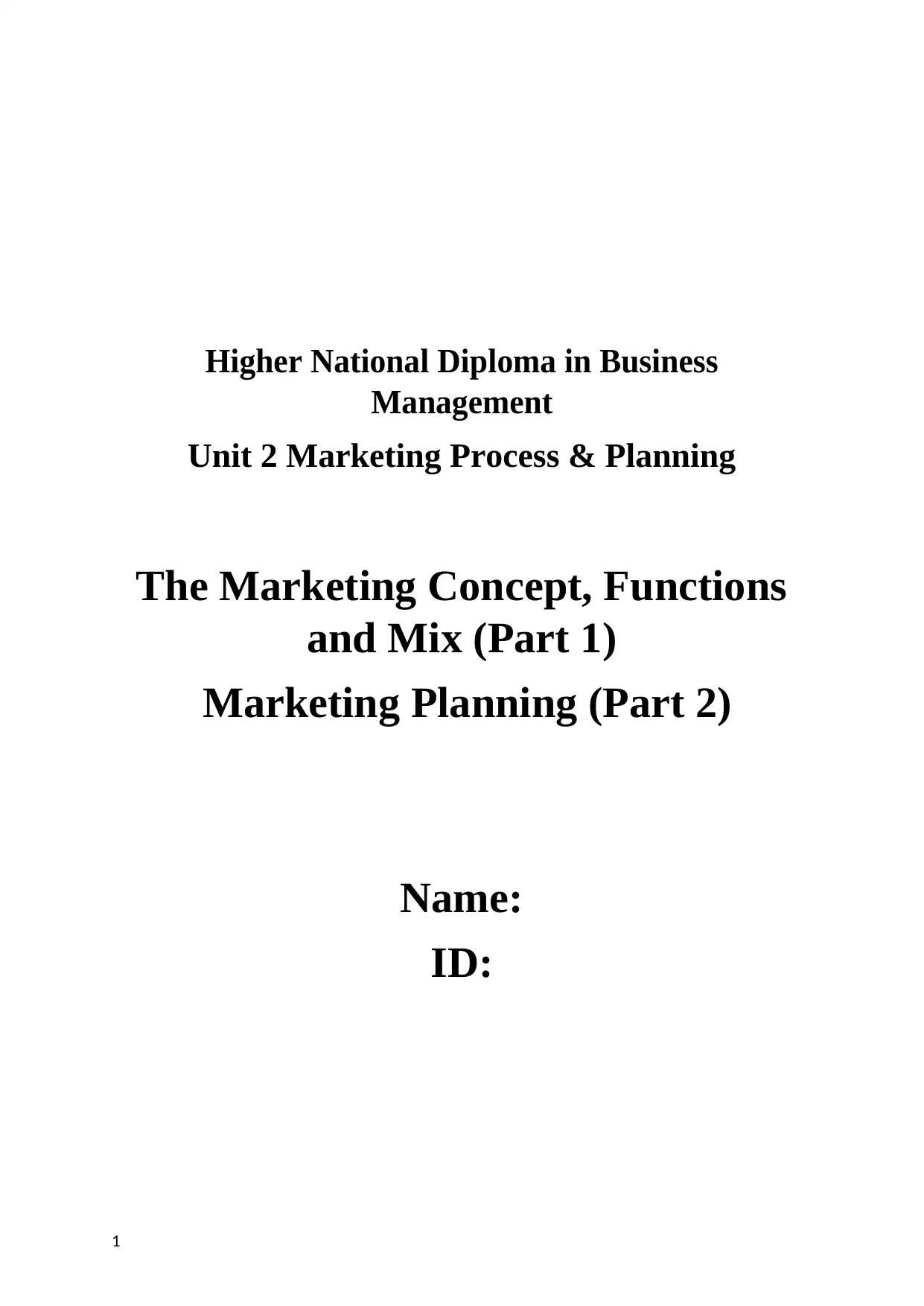
Higher National Diploma in Business
Management
Unit 2 Marketing Process & Planning
The Marketing Concept, Functions
and Mix (Part 1)
Marketing Planning (Part 2)
Name:
ID:
1
Management
Unit 2 Marketing Process & Planning
The Marketing Concept, Functions
and Mix (Part 1)
Marketing Planning (Part 2)
Name:
ID:
1
Paraphrase This Document
Need a fresh take? Get an instant paraphrase of this document with our AI Paraphraser
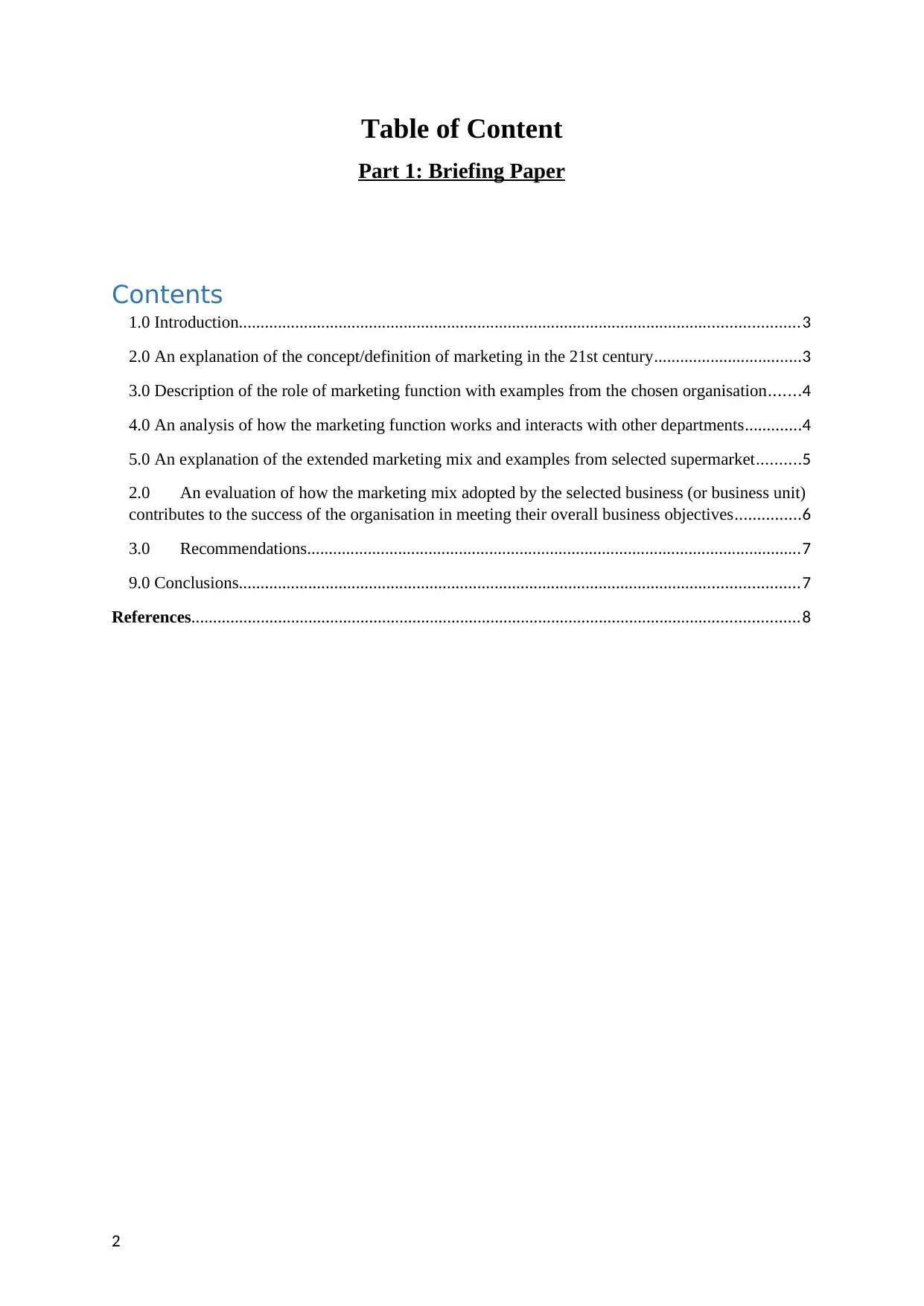
Table of Content
Part 1: Briefing Paper
Contents
1.0 Introduction.................................................................................................................................3
2.0 An explanation of the concept/definition of marketing in the 21st century..................................3
3.0 Description of the role of marketing function with examples from the chosen organisation.......4
4.0 An analysis of how the marketing function works and interacts with other departments.............4
5.0 An explanation of the extended marketing mix and examples from selected supermarket..........5
2.0 An evaluation of how the marketing mix adopted by the selected business (or business unit)
contributes to the success of the organisation in meeting their overall business objectives...............6
3.0 Recommendations..................................................................................................................7
9.0 Conclusions.................................................................................................................................7
References............................................................................................................................................8
2
Part 1: Briefing Paper
Contents
1.0 Introduction.................................................................................................................................3
2.0 An explanation of the concept/definition of marketing in the 21st century..................................3
3.0 Description of the role of marketing function with examples from the chosen organisation.......4
4.0 An analysis of how the marketing function works and interacts with other departments.............4
5.0 An explanation of the extended marketing mix and examples from selected supermarket..........5
2.0 An evaluation of how the marketing mix adopted by the selected business (or business unit)
contributes to the success of the organisation in meeting their overall business objectives...............6
3.0 Recommendations..................................................................................................................7
9.0 Conclusions.................................................................................................................................7
References............................................................................................................................................8
2
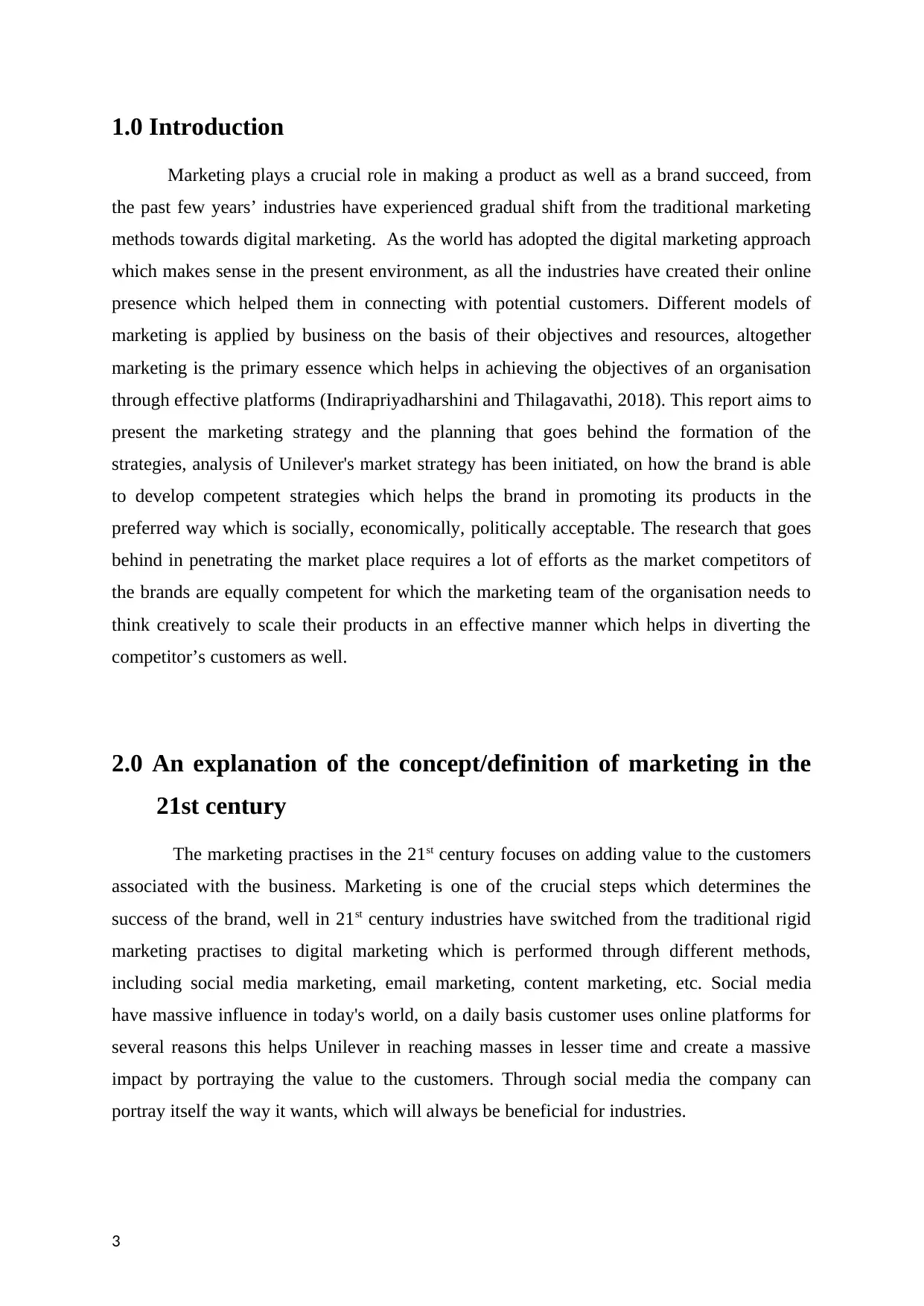
1.0 Introduction
Marketing plays a crucial role in making a product as well as a brand succeed, from
the past few years’ industries have experienced gradual shift from the traditional marketing
methods towards digital marketing. As the world has adopted the digital marketing approach
which makes sense in the present environment, as all the industries have created their online
presence which helped them in connecting with potential customers. Different models of
marketing is applied by business on the basis of their objectives and resources, altogether
marketing is the primary essence which helps in achieving the objectives of an organisation
through effective platforms (Indirapriyadharshini and Thilagavathi, 2018). This report aims to
present the marketing strategy and the planning that goes behind the formation of the
strategies, analysis of Unilever's market strategy has been initiated, on how the brand is able
to develop competent strategies which helps the brand in promoting its products in the
preferred way which is socially, economically, politically acceptable. The research that goes
behind in penetrating the market place requires a lot of efforts as the market competitors of
the brands are equally competent for which the marketing team of the organisation needs to
think creatively to scale their products in an effective manner which helps in diverting the
competitor’s customers as well.
2.0 An explanation of the concept/definition of marketing in the
21st century
The marketing practises in the 21st century focuses on adding value to the customers
associated with the business. Marketing is one of the crucial steps which determines the
success of the brand, well in 21st century industries have switched from the traditional rigid
marketing practises to digital marketing which is performed through different methods,
including social media marketing, email marketing, content marketing, etc. Social media
have massive influence in today's world, on a daily basis customer uses online platforms for
several reasons this helps Unilever in reaching masses in lesser time and create a massive
impact by portraying the value to the customers. Through social media the company can
portray itself the way it wants, which will always be beneficial for industries.
3
Marketing plays a crucial role in making a product as well as a brand succeed, from
the past few years’ industries have experienced gradual shift from the traditional marketing
methods towards digital marketing. As the world has adopted the digital marketing approach
which makes sense in the present environment, as all the industries have created their online
presence which helped them in connecting with potential customers. Different models of
marketing is applied by business on the basis of their objectives and resources, altogether
marketing is the primary essence which helps in achieving the objectives of an organisation
through effective platforms (Indirapriyadharshini and Thilagavathi, 2018). This report aims to
present the marketing strategy and the planning that goes behind the formation of the
strategies, analysis of Unilever's market strategy has been initiated, on how the brand is able
to develop competent strategies which helps the brand in promoting its products in the
preferred way which is socially, economically, politically acceptable. The research that goes
behind in penetrating the market place requires a lot of efforts as the market competitors of
the brands are equally competent for which the marketing team of the organisation needs to
think creatively to scale their products in an effective manner which helps in diverting the
competitor’s customers as well.
2.0 An explanation of the concept/definition of marketing in the
21st century
The marketing practises in the 21st century focuses on adding value to the customers
associated with the business. Marketing is one of the crucial steps which determines the
success of the brand, well in 21st century industries have switched from the traditional rigid
marketing practises to digital marketing which is performed through different methods,
including social media marketing, email marketing, content marketing, etc. Social media
have massive influence in today's world, on a daily basis customer uses online platforms for
several reasons this helps Unilever in reaching masses in lesser time and create a massive
impact by portraying the value to the customers. Through social media the company can
portray itself the way it wants, which will always be beneficial for industries.
3
⊘ This is a preview!⊘
Do you want full access?
Subscribe today to unlock all pages.

Trusted by 1+ million students worldwide

The modern marketing tactics are beneficial in all the possible ways it has reduced the
investment that was being done on the traditional marketing methods, the reach of the
modern marketing is far more beyond than the traditional methods. 21st century marketing has
provided benefits to many that was beyond imagination and have served the goal for Unilever
as well.
3.0 Description of the role of marketing function with examples
from the chosen organisation
Unilever has stated that they use social media for showing the benefits of their products to the
customers. Sustainability is the ultimate goal of the brand which can been seen in the brand
advertisements, the campaign run for dove soaps, which aim was to make people feel
comfortable about their own skin and not promoting racism. The detergents advertisements
portraying that kids getting dirty is normal and a part in their growth years. Through all the
social media platforms the brand is constantly trying to create and sustain the market
presence of the brand (Nadeemet.al, 2019). Unilever follows the ICC code in each and every
advertisements as this code of conduct verifies that the content is legal, safe, and presentable.
The marketing team is responsible for handling and managing the market presence of the
brand, for which the it should be very clear to the team that what they do, how they do and
what values they carry and in what way they are willing to present it. Conducting campaigns
gives the overall perspective on the topic, which the team needs to work on which ultimately
helps the management team in understanding the core concern which helps in decision
formation. Customer service is also a major factor as it helps in understanding the needs
along with the ways in which the people need it to be resolved.
4.0 An analysis of how the marketing function works and
interacts with other departments
Marketing is a multidimensional department which deals with many aspects at a time as the
marketing of the company is affected by internal along with external factors which makes it
complex at times (Stone,,et.al 2021). Marketing is responsible for the success, not only for
4
investment that was being done on the traditional marketing methods, the reach of the
modern marketing is far more beyond than the traditional methods. 21st century marketing has
provided benefits to many that was beyond imagination and have served the goal for Unilever
as well.
3.0 Description of the role of marketing function with examples
from the chosen organisation
Unilever has stated that they use social media for showing the benefits of their products to the
customers. Sustainability is the ultimate goal of the brand which can been seen in the brand
advertisements, the campaign run for dove soaps, which aim was to make people feel
comfortable about their own skin and not promoting racism. The detergents advertisements
portraying that kids getting dirty is normal and a part in their growth years. Through all the
social media platforms the brand is constantly trying to create and sustain the market
presence of the brand (Nadeemet.al, 2019). Unilever follows the ICC code in each and every
advertisements as this code of conduct verifies that the content is legal, safe, and presentable.
The marketing team is responsible for handling and managing the market presence of the
brand, for which the it should be very clear to the team that what they do, how they do and
what values they carry and in what way they are willing to present it. Conducting campaigns
gives the overall perspective on the topic, which the team needs to work on which ultimately
helps the management team in understanding the core concern which helps in decision
formation. Customer service is also a major factor as it helps in understanding the needs
along with the ways in which the people need it to be resolved.
4.0 An analysis of how the marketing function works and
interacts with other departments
Marketing is a multidimensional department which deals with many aspects at a time as the
marketing of the company is affected by internal along with external factors which makes it
complex at times (Stone,,et.al 2021). Marketing is responsible for the success, not only for
4
Paraphrase This Document
Need a fresh take? Get an instant paraphrase of this document with our AI Paraphraser

the product but also for the company, if the goods and services will not be marketed well, it
will not be able to derive the new customers which will not be beneficial for the brand in any
ways. Marketing is the only way through which the brand image could be created,
transformed or sustained.
Sales: Marketing and sales works parallels, as marketing focuses on attracting the customers
to the business and sales teams focuses on sealing the product to the customers and increase
the customer base. As the sales department is not only connected with the marketing but also
with the finance, production, supply chain etc., as all the major processes will be depending
on these factors itself.
Finance: Marketing requires funds and if the company doesn't have adequate fiancé the
desired results will be tough to achieve (Singh, and Abidi, 2021). It is the finance department
which let the marketing team function effectively and achieve the desired results. Marketing
teams are accountable to the finance department as they need to explain their expenditures to
them.
Production: Marketing and production department requires effective communication among
themselves, if these departments do not experience a cordial relation could lead to many
serious problems. As when the customers are attracted and the sales are made it is production
team which is required to meet the requirements of the brand, which cannot be procrastinated
or ignored as it will impact the market presence of Unilever.
Supply Chain: There should be regular communication between the marketing and supply
chain department as they are required to know the amount of sales made or about to be made
which provides them an idea, which helps them in providing the good and services to the
customers within the expected time.
5.0 An explanation of the extended marketing mix and examples
from selected supermarket
The company uses the 4Ps marketing strategy to market its product to the targeted audience.
The 4ps revolve around the price, place, product and promotion of it. As Unilever is a global
brand formed with 400 different brands, which makes the place and product factor crucial as
5
will not be able to derive the new customers which will not be beneficial for the brand in any
ways. Marketing is the only way through which the brand image could be created,
transformed or sustained.
Sales: Marketing and sales works parallels, as marketing focuses on attracting the customers
to the business and sales teams focuses on sealing the product to the customers and increase
the customer base. As the sales department is not only connected with the marketing but also
with the finance, production, supply chain etc., as all the major processes will be depending
on these factors itself.
Finance: Marketing requires funds and if the company doesn't have adequate fiancé the
desired results will be tough to achieve (Singh, and Abidi, 2021). It is the finance department
which let the marketing team function effectively and achieve the desired results. Marketing
teams are accountable to the finance department as they need to explain their expenditures to
them.
Production: Marketing and production department requires effective communication among
themselves, if these departments do not experience a cordial relation could lead to many
serious problems. As when the customers are attracted and the sales are made it is production
team which is required to meet the requirements of the brand, which cannot be procrastinated
or ignored as it will impact the market presence of Unilever.
Supply Chain: There should be regular communication between the marketing and supply
chain department as they are required to know the amount of sales made or about to be made
which provides them an idea, which helps them in providing the good and services to the
customers within the expected time.
5.0 An explanation of the extended marketing mix and examples
from selected supermarket
The company uses the 4Ps marketing strategy to market its product to the targeted audience.
The 4ps revolve around the price, place, product and promotion of it. As Unilever is a global
brand formed with 400 different brands, which makes the place and product factor crucial as
5
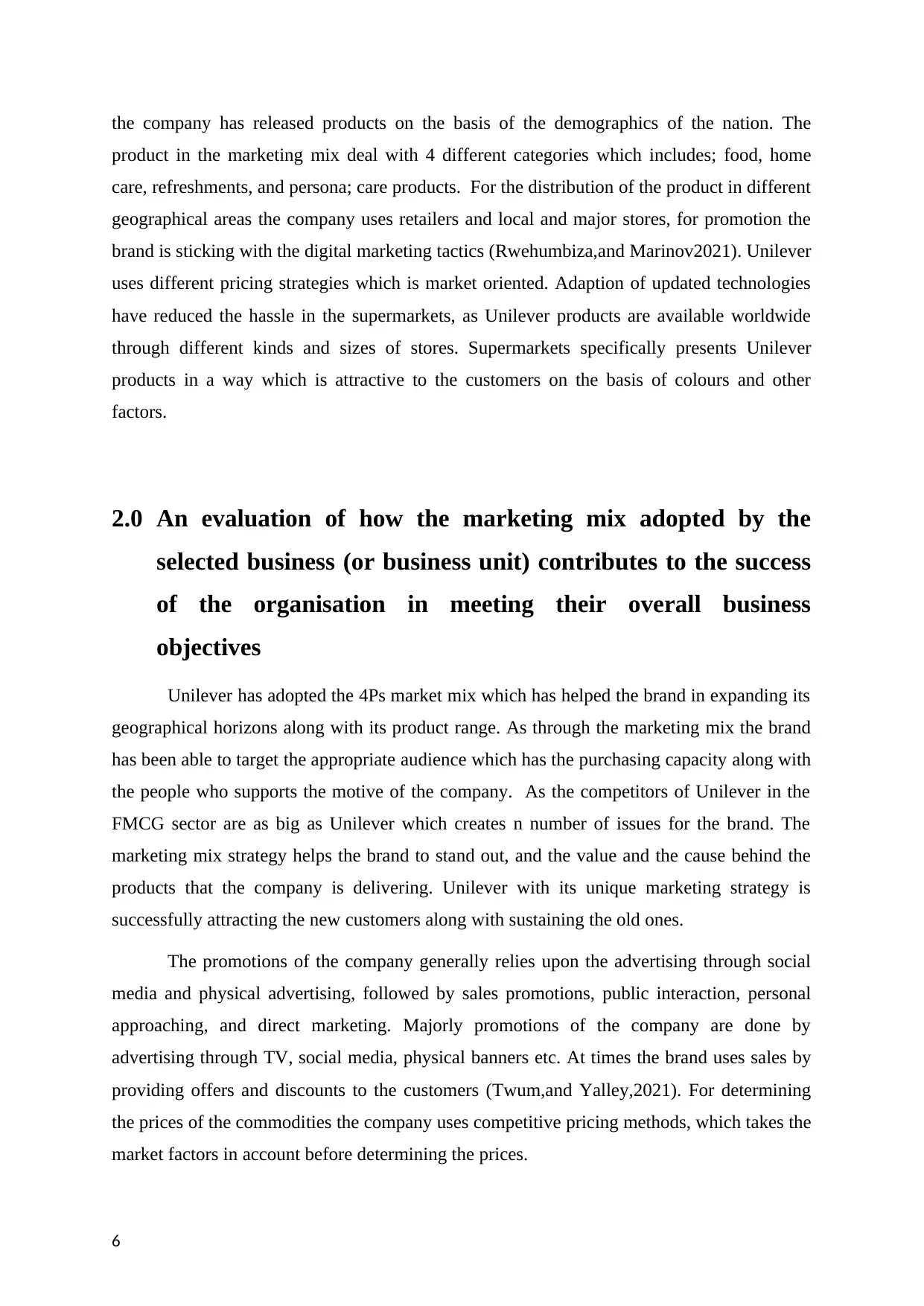
the company has released products on the basis of the demographics of the nation. The
product in the marketing mix deal with 4 different categories which includes; food, home
care, refreshments, and persona; care products. For the distribution of the product in different
geographical areas the company uses retailers and local and major stores, for promotion the
brand is sticking with the digital marketing tactics (Rwehumbiza,and Marinov2021). Unilever
uses different pricing strategies which is market oriented. Adaption of updated technologies
have reduced the hassle in the supermarkets, as Unilever products are available worldwide
through different kinds and sizes of stores. Supermarkets specifically presents Unilever
products in a way which is attractive to the customers on the basis of colours and other
factors.
2.0 An evaluation of how the marketing mix adopted by the
selected business (or business unit) contributes to the success
of the organisation in meeting their overall business
objectives
Unilever has adopted the 4Ps market mix which has helped the brand in expanding its
geographical horizons along with its product range. As through the marketing mix the brand
has been able to target the appropriate audience which has the purchasing capacity along with
the people who supports the motive of the company. As the competitors of Unilever in the
FMCG sector are as big as Unilever which creates n number of issues for the brand. The
marketing mix strategy helps the brand to stand out, and the value and the cause behind the
products that the company is delivering. Unilever with its unique marketing strategy is
successfully attracting the new customers along with sustaining the old ones.
The promotions of the company generally relies upon the advertising through social
media and physical advertising, followed by sales promotions, public interaction, personal
approaching, and direct marketing. Majorly promotions of the company are done by
advertising through TV, social media, physical banners etc. At times the brand uses sales by
providing offers and discounts to the customers (Twum,and Yalley,2021). For determining
the prices of the commodities the company uses competitive pricing methods, which takes the
market factors in account before determining the prices.
6
product in the marketing mix deal with 4 different categories which includes; food, home
care, refreshments, and persona; care products. For the distribution of the product in different
geographical areas the company uses retailers and local and major stores, for promotion the
brand is sticking with the digital marketing tactics (Rwehumbiza,and Marinov2021). Unilever
uses different pricing strategies which is market oriented. Adaption of updated technologies
have reduced the hassle in the supermarkets, as Unilever products are available worldwide
through different kinds and sizes of stores. Supermarkets specifically presents Unilever
products in a way which is attractive to the customers on the basis of colours and other
factors.
2.0 An evaluation of how the marketing mix adopted by the
selected business (or business unit) contributes to the success
of the organisation in meeting their overall business
objectives
Unilever has adopted the 4Ps market mix which has helped the brand in expanding its
geographical horizons along with its product range. As through the marketing mix the brand
has been able to target the appropriate audience which has the purchasing capacity along with
the people who supports the motive of the company. As the competitors of Unilever in the
FMCG sector are as big as Unilever which creates n number of issues for the brand. The
marketing mix strategy helps the brand to stand out, and the value and the cause behind the
products that the company is delivering. Unilever with its unique marketing strategy is
successfully attracting the new customers along with sustaining the old ones.
The promotions of the company generally relies upon the advertising through social
media and physical advertising, followed by sales promotions, public interaction, personal
approaching, and direct marketing. Majorly promotions of the company are done by
advertising through TV, social media, physical banners etc. At times the brand uses sales by
providing offers and discounts to the customers (Twum,and Yalley,2021). For determining
the prices of the commodities the company uses competitive pricing methods, which takes the
market factors in account before determining the prices.
6
⊘ This is a preview!⊘
Do you want full access?
Subscribe today to unlock all pages.

Trusted by 1+ million students worldwide
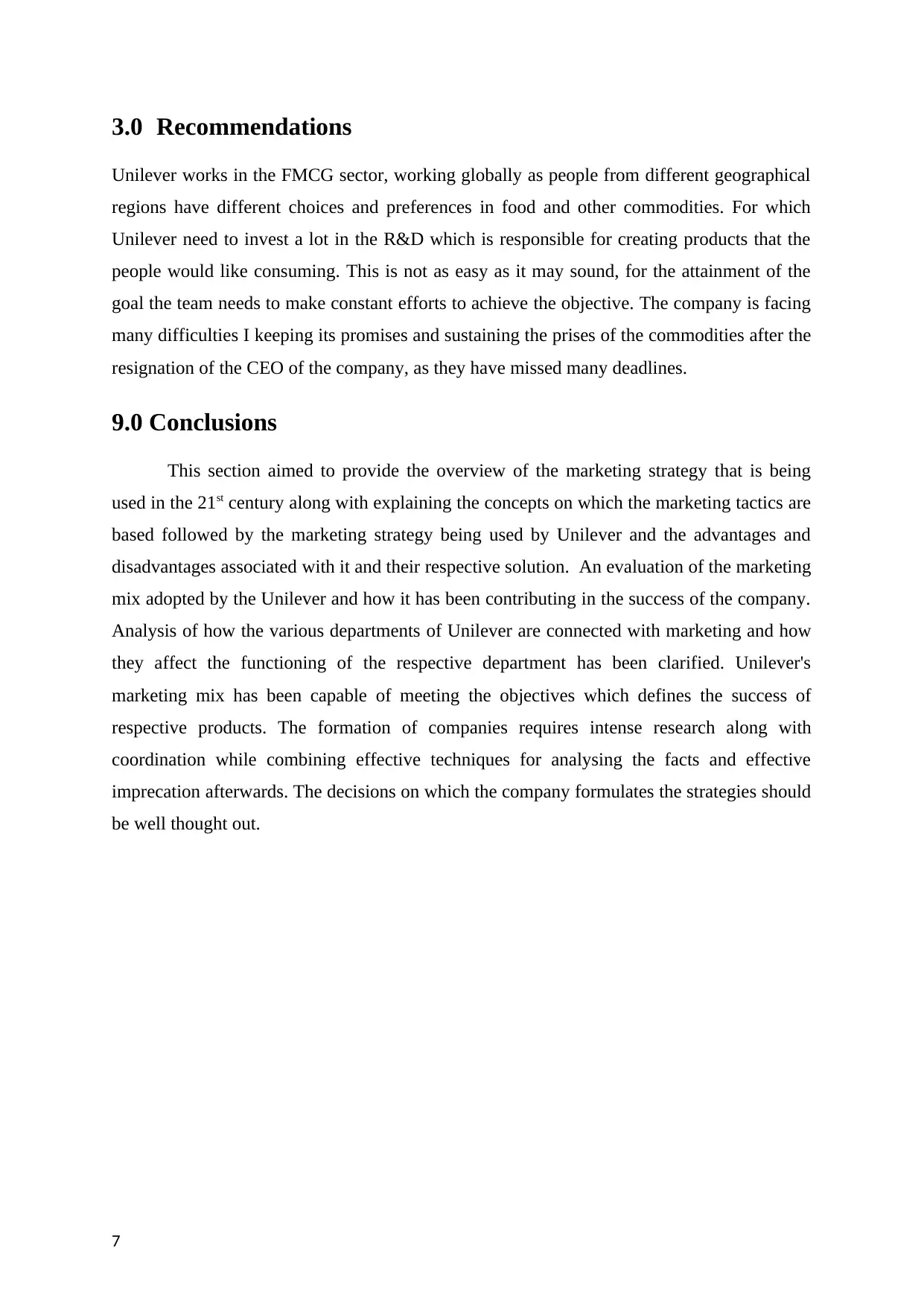
3.0 Recommendations
Unilever works in the FMCG sector, working globally as people from different geographical
regions have different choices and preferences in food and other commodities. For which
Unilever need to invest a lot in the R&D which is responsible for creating products that the
people would like consuming. This is not as easy as it may sound, for the attainment of the
goal the team needs to make constant efforts to achieve the objective. The company is facing
many difficulties I keeping its promises and sustaining the prises of the commodities after the
resignation of the CEO of the company, as they have missed many deadlines.
9.0 Conclusions
This section aimed to provide the overview of the marketing strategy that is being
used in the 21st century along with explaining the concepts on which the marketing tactics are
based followed by the marketing strategy being used by Unilever and the advantages and
disadvantages associated with it and their respective solution. An evaluation of the marketing
mix adopted by the Unilever and how it has been contributing in the success of the company.
Analysis of how the various departments of Unilever are connected with marketing and how
they affect the functioning of the respective department has been clarified. Unilever's
marketing mix has been capable of meeting the objectives which defines the success of
respective products. The formation of companies requires intense research along with
coordination while combining effective techniques for analysing the facts and effective
imprecation afterwards. The decisions on which the company formulates the strategies should
be well thought out.
7
Unilever works in the FMCG sector, working globally as people from different geographical
regions have different choices and preferences in food and other commodities. For which
Unilever need to invest a lot in the R&D which is responsible for creating products that the
people would like consuming. This is not as easy as it may sound, for the attainment of the
goal the team needs to make constant efforts to achieve the objective. The company is facing
many difficulties I keeping its promises and sustaining the prises of the commodities after the
resignation of the CEO of the company, as they have missed many deadlines.
9.0 Conclusions
This section aimed to provide the overview of the marketing strategy that is being
used in the 21st century along with explaining the concepts on which the marketing tactics are
based followed by the marketing strategy being used by Unilever and the advantages and
disadvantages associated with it and their respective solution. An evaluation of the marketing
mix adopted by the Unilever and how it has been contributing in the success of the company.
Analysis of how the various departments of Unilever are connected with marketing and how
they affect the functioning of the respective department has been clarified. Unilever's
marketing mix has been capable of meeting the objectives which defines the success of
respective products. The formation of companies requires intense research along with
coordination while combining effective techniques for analysing the facts and effective
imprecation afterwards. The decisions on which the company formulates the strategies should
be well thought out.
7
Paraphrase This Document
Need a fresh take? Get an instant paraphrase of this document with our AI Paraphraser
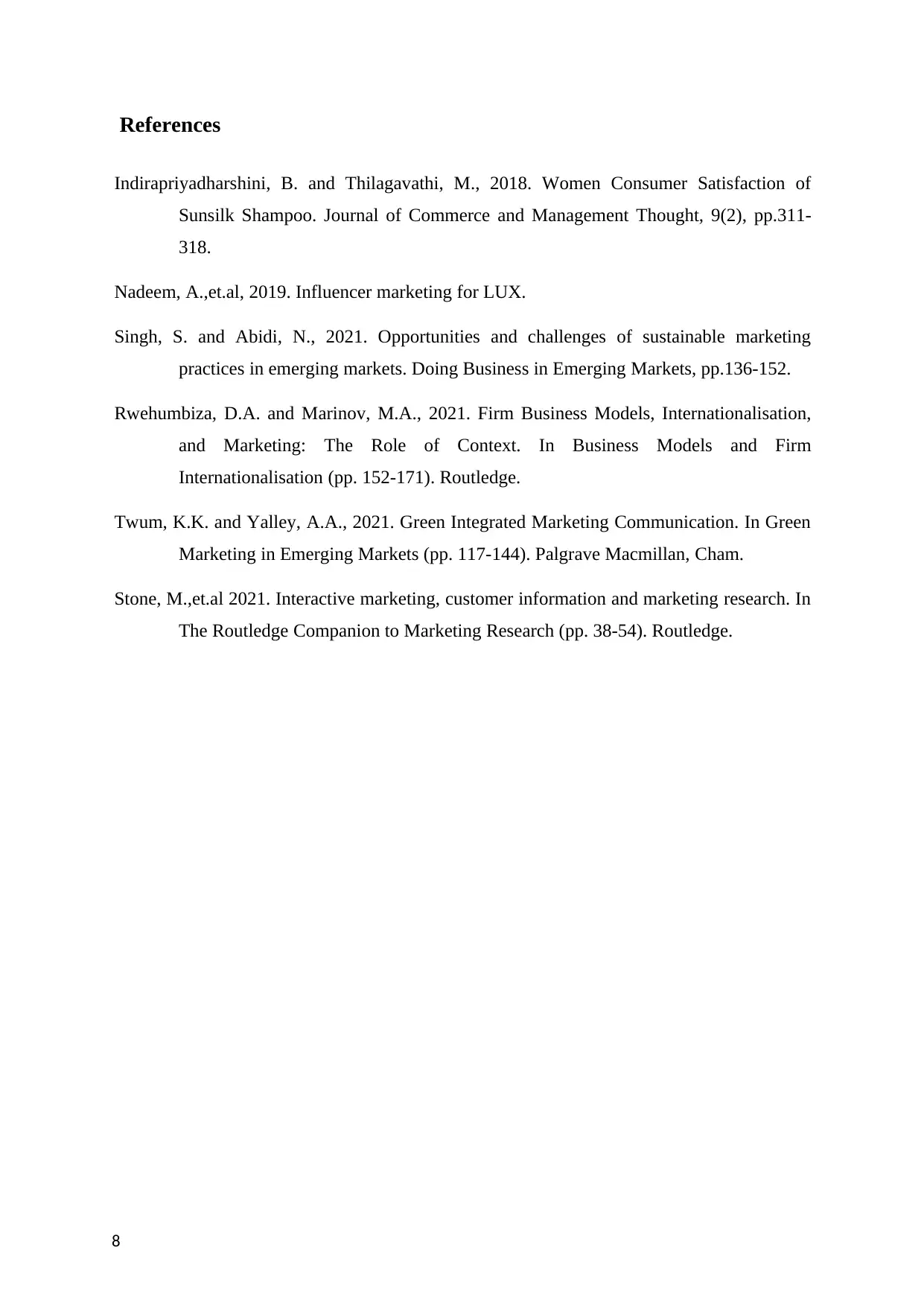
References
Indirapriyadharshini, B. and Thilagavathi, M., 2018. Women Consumer Satisfaction of
Sunsilk Shampoo. Journal of Commerce and Management Thought, 9(2), pp.311-
318.
Nadeem, A.,et.al, 2019. Influencer marketing for LUX.
Singh, S. and Abidi, N., 2021. Opportunities and challenges of sustainable marketing
practices in emerging markets. Doing Business in Emerging Markets, pp.136-152.
Rwehumbiza, D.A. and Marinov, M.A., 2021. Firm Business Models, Internationalisation,
and Marketing: The Role of Context. In Business Models and Firm
Internationalisation (pp. 152-171). Routledge.
Twum, K.K. and Yalley, A.A., 2021. Green Integrated Marketing Communication. In Green
Marketing in Emerging Markets (pp. 117-144). Palgrave Macmillan, Cham.
Stone, M.,et.al 2021. Interactive marketing, customer information and marketing research. In
The Routledge Companion to Marketing Research (pp. 38-54). Routledge.
8
Indirapriyadharshini, B. and Thilagavathi, M., 2018. Women Consumer Satisfaction of
Sunsilk Shampoo. Journal of Commerce and Management Thought, 9(2), pp.311-
318.
Nadeem, A.,et.al, 2019. Influencer marketing for LUX.
Singh, S. and Abidi, N., 2021. Opportunities and challenges of sustainable marketing
practices in emerging markets. Doing Business in Emerging Markets, pp.136-152.
Rwehumbiza, D.A. and Marinov, M.A., 2021. Firm Business Models, Internationalisation,
and Marketing: The Role of Context. In Business Models and Firm
Internationalisation (pp. 152-171). Routledge.
Twum, K.K. and Yalley, A.A., 2021. Green Integrated Marketing Communication. In Green
Marketing in Emerging Markets (pp. 117-144). Palgrave Macmillan, Cham.
Stone, M.,et.al 2021. Interactive marketing, customer information and marketing research. In
The Routledge Companion to Marketing Research (pp. 38-54). Routledge.
8
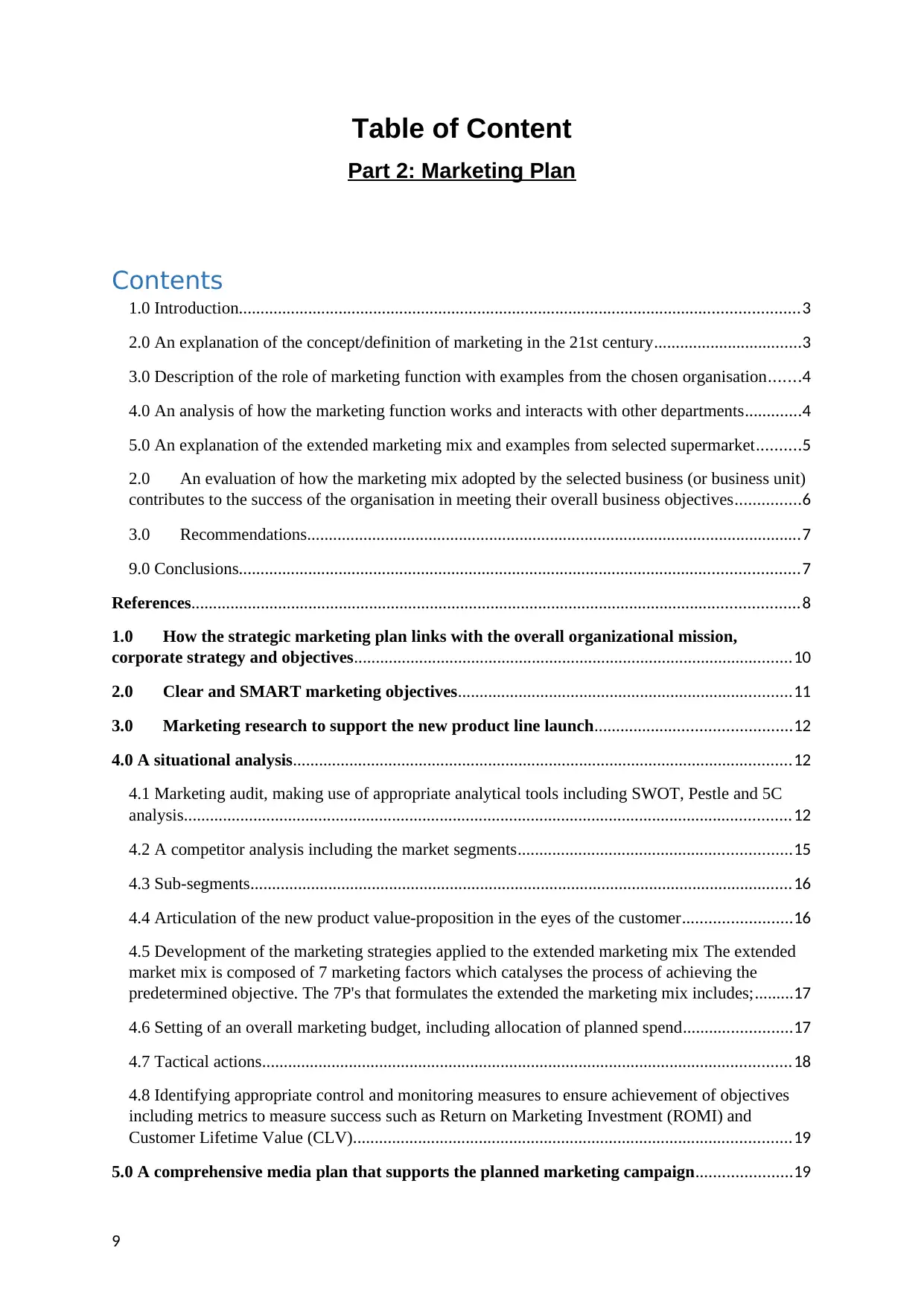
Table of Content
Part 2: Marketing Plan
Contents
1.0 Introduction.................................................................................................................................3
2.0 An explanation of the concept/definition of marketing in the 21st century..................................3
3.0 Description of the role of marketing function with examples from the chosen organisation.......4
4.0 An analysis of how the marketing function works and interacts with other departments.............4
5.0 An explanation of the extended marketing mix and examples from selected supermarket..........5
2.0 An evaluation of how the marketing mix adopted by the selected business (or business unit)
contributes to the success of the organisation in meeting their overall business objectives...............6
3.0 Recommendations..................................................................................................................7
9.0 Conclusions.................................................................................................................................7
References............................................................................................................................................8
1.0 How the strategic marketing plan links with the overall organizational mission,
corporate strategy and objectives.....................................................................................................10
2.0 Clear and SMART marketing objectives.............................................................................11
3.0 Marketing research to support the new product line launch.............................................12
4.0 A situational analysis...................................................................................................................12
4.1 Marketing audit, making use of appropriate analytical tools including SWOT, Pestle and 5C
analysis............................................................................................................................................12
4.2 A competitor analysis including the market segments...............................................................15
4.3 Sub-segments.............................................................................................................................16
4.4 Articulation of the new product value-proposition in the eyes of the customer.........................16
4.5 Development of the marketing strategies applied to the extended marketing mix The extended
market mix is composed of 7 marketing factors which catalyses the process of achieving the
predetermined objective. The 7P's that formulates the extended the marketing mix includes;.........17
4.6 Setting of an overall marketing budget, including allocation of planned spend.........................17
4.7 Tactical actions..........................................................................................................................18
4.8 Identifying appropriate control and monitoring measures to ensure achievement of objectives
including metrics to measure success such as Return on Marketing Investment (ROMI) and
Customer Lifetime Value (CLV).....................................................................................................19
5.0 A comprehensive media plan that supports the planned marketing campaign......................19
9
Part 2: Marketing Plan
Contents
1.0 Introduction.................................................................................................................................3
2.0 An explanation of the concept/definition of marketing in the 21st century..................................3
3.0 Description of the role of marketing function with examples from the chosen organisation.......4
4.0 An analysis of how the marketing function works and interacts with other departments.............4
5.0 An explanation of the extended marketing mix and examples from selected supermarket..........5
2.0 An evaluation of how the marketing mix adopted by the selected business (or business unit)
contributes to the success of the organisation in meeting their overall business objectives...............6
3.0 Recommendations..................................................................................................................7
9.0 Conclusions.................................................................................................................................7
References............................................................................................................................................8
1.0 How the strategic marketing plan links with the overall organizational mission,
corporate strategy and objectives.....................................................................................................10
2.0 Clear and SMART marketing objectives.............................................................................11
3.0 Marketing research to support the new product line launch.............................................12
4.0 A situational analysis...................................................................................................................12
4.1 Marketing audit, making use of appropriate analytical tools including SWOT, Pestle and 5C
analysis............................................................................................................................................12
4.2 A competitor analysis including the market segments...............................................................15
4.3 Sub-segments.............................................................................................................................16
4.4 Articulation of the new product value-proposition in the eyes of the customer.........................16
4.5 Development of the marketing strategies applied to the extended marketing mix The extended
market mix is composed of 7 marketing factors which catalyses the process of achieving the
predetermined objective. The 7P's that formulates the extended the marketing mix includes;.........17
4.6 Setting of an overall marketing budget, including allocation of planned spend.........................17
4.7 Tactical actions..........................................................................................................................18
4.8 Identifying appropriate control and monitoring measures to ensure achievement of objectives
including metrics to measure success such as Return on Marketing Investment (ROMI) and
Customer Lifetime Value (CLV).....................................................................................................19
5.0 A comprehensive media plan that supports the planned marketing campaign......................19
9
⊘ This is a preview!⊘
Do you want full access?
Subscribe today to unlock all pages.

Trusted by 1+ million students worldwide

5.1 A media budget..........................................................................................................................19
5.2 Recommendations and rationale for selected and integrated multi-media activities within the set
budget that meet the marketing objectives.......................................................................................19
5.3 Appropriate digital, offline and social media channels for communication...............................20
5.6 Full justification for a multi-media plan based on quantitative and qualitative criteria..............20
References..........................................................................................................................................20
1.0 How the strategic marketing plan links with the overall
organizational mission, corporate strategy and objectives
Unilever is considered as one of the most successful brands in the world, which has
successfully launched and scaled its products in markets across the globe. The mission and
objectives of the brand leans towards sustainability and abolishing racial elements from the
society, for which the company is using its marketing campaigns to convey its message to the
10
5.2 Recommendations and rationale for selected and integrated multi-media activities within the set
budget that meet the marketing objectives.......................................................................................19
5.3 Appropriate digital, offline and social media channels for communication...............................20
5.6 Full justification for a multi-media plan based on quantitative and qualitative criteria..............20
References..........................................................................................................................................20
1.0 How the strategic marketing plan links with the overall
organizational mission, corporate strategy and objectives
Unilever is considered as one of the most successful brands in the world, which has
successfully launched and scaled its products in markets across the globe. The mission and
objectives of the brand leans towards sustainability and abolishing racial elements from the
society, for which the company is using its marketing campaigns to convey its message to the
10
Paraphrase This Document
Need a fresh take? Get an instant paraphrase of this document with our AI Paraphraser
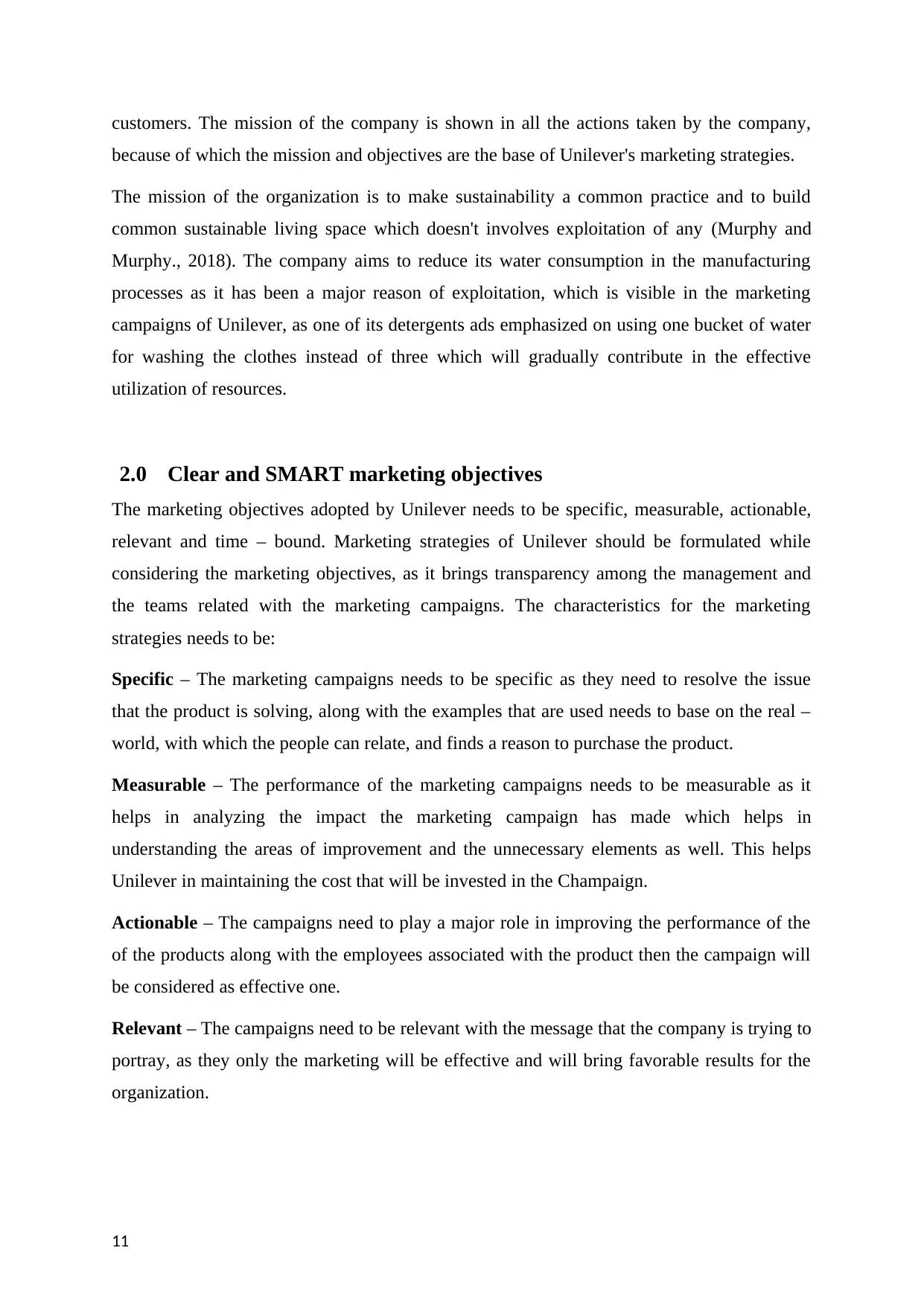
customers. The mission of the company is shown in all the actions taken by the company,
because of which the mission and objectives are the base of Unilever's marketing strategies.
The mission of the organization is to make sustainability a common practice and to build
common sustainable living space which doesn't involves exploitation of any (Murphy and
Murphy., 2018). The company aims to reduce its water consumption in the manufacturing
processes as it has been a major reason of exploitation, which is visible in the marketing
campaigns of Unilever, as one of its detergents ads emphasized on using one bucket of water
for washing the clothes instead of three which will gradually contribute in the effective
utilization of resources.
2.0 Clear and SMART marketing objectives
The marketing objectives adopted by Unilever needs to be specific, measurable, actionable,
relevant and time – bound. Marketing strategies of Unilever should be formulated while
considering the marketing objectives, as it brings transparency among the management and
the teams related with the marketing campaigns. The characteristics for the marketing
strategies needs to be:
Specific – The marketing campaigns needs to be specific as they need to resolve the issue
that the product is solving, along with the examples that are used needs to base on the real –
world, with which the people can relate, and finds a reason to purchase the product.
Measurable – The performance of the marketing campaigns needs to be measurable as it
helps in analyzing the impact the marketing campaign has made which helps in
understanding the areas of improvement and the unnecessary elements as well. This helps
Unilever in maintaining the cost that will be invested in the Champaign.
Actionable – The campaigns need to play a major role in improving the performance of the
of the products along with the employees associated with the product then the campaign will
be considered as effective one.
Relevant – The campaigns need to be relevant with the message that the company is trying to
portray, as they only the marketing will be effective and will bring favorable results for the
organization.
11
because of which the mission and objectives are the base of Unilever's marketing strategies.
The mission of the organization is to make sustainability a common practice and to build
common sustainable living space which doesn't involves exploitation of any (Murphy and
Murphy., 2018). The company aims to reduce its water consumption in the manufacturing
processes as it has been a major reason of exploitation, which is visible in the marketing
campaigns of Unilever, as one of its detergents ads emphasized on using one bucket of water
for washing the clothes instead of three which will gradually contribute in the effective
utilization of resources.
2.0 Clear and SMART marketing objectives
The marketing objectives adopted by Unilever needs to be specific, measurable, actionable,
relevant and time – bound. Marketing strategies of Unilever should be formulated while
considering the marketing objectives, as it brings transparency among the management and
the teams related with the marketing campaigns. The characteristics for the marketing
strategies needs to be:
Specific – The marketing campaigns needs to be specific as they need to resolve the issue
that the product is solving, along with the examples that are used needs to base on the real –
world, with which the people can relate, and finds a reason to purchase the product.
Measurable – The performance of the marketing campaigns needs to be measurable as it
helps in analyzing the impact the marketing campaign has made which helps in
understanding the areas of improvement and the unnecessary elements as well. This helps
Unilever in maintaining the cost that will be invested in the Champaign.
Actionable – The campaigns need to play a major role in improving the performance of the
of the products along with the employees associated with the product then the campaign will
be considered as effective one.
Relevant – The campaigns need to be relevant with the message that the company is trying to
portray, as they only the marketing will be effective and will bring favorable results for the
organization.
11
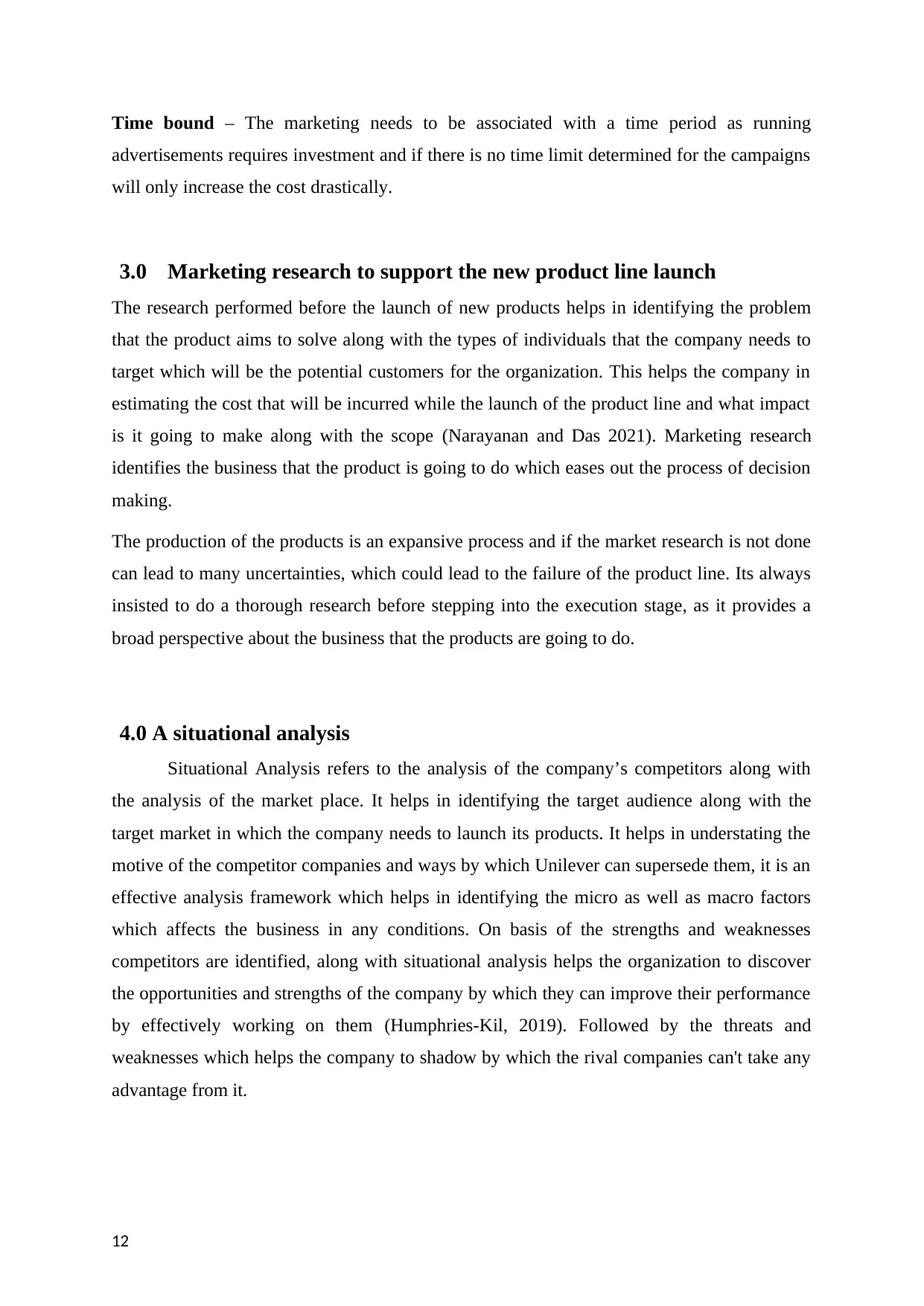
Time bound – The marketing needs to be associated with a time period as running
advertisements requires investment and if there is no time limit determined for the campaigns
will only increase the cost drastically.
3.0 Marketing research to support the new product line launch
The research performed before the launch of new products helps in identifying the problem
that the product aims to solve along with the types of individuals that the company needs to
target which will be the potential customers for the organization. This helps the company in
estimating the cost that will be incurred while the launch of the product line and what impact
is it going to make along with the scope (Narayanan and Das 2021). Marketing research
identifies the business that the product is going to do which eases out the process of decision
making.
The production of the products is an expansive process and if the market research is not done
can lead to many uncertainties, which could lead to the failure of the product line. Its always
insisted to do a thorough research before stepping into the execution stage, as it provides a
broad perspective about the business that the products are going to do.
4.0 A situational analysis
Situational Analysis refers to the analysis of the company’s competitors along with
the analysis of the market place. It helps in identifying the target audience along with the
target market in which the company needs to launch its products. It helps in understating the
motive of the competitor companies and ways by which Unilever can supersede them, it is an
effective analysis framework which helps in identifying the micro as well as macro factors
which affects the business in any conditions. On basis of the strengths and weaknesses
competitors are identified, along with situational analysis helps the organization to discover
the opportunities and strengths of the company by which they can improve their performance
by effectively working on them (Humphries-Kil, 2019). Followed by the threats and
weaknesses which helps the company to shadow by which the rival companies can't take any
advantage from it.
12
advertisements requires investment and if there is no time limit determined for the campaigns
will only increase the cost drastically.
3.0 Marketing research to support the new product line launch
The research performed before the launch of new products helps in identifying the problem
that the product aims to solve along with the types of individuals that the company needs to
target which will be the potential customers for the organization. This helps the company in
estimating the cost that will be incurred while the launch of the product line and what impact
is it going to make along with the scope (Narayanan and Das 2021). Marketing research
identifies the business that the product is going to do which eases out the process of decision
making.
The production of the products is an expansive process and if the market research is not done
can lead to many uncertainties, which could lead to the failure of the product line. Its always
insisted to do a thorough research before stepping into the execution stage, as it provides a
broad perspective about the business that the products are going to do.
4.0 A situational analysis
Situational Analysis refers to the analysis of the company’s competitors along with
the analysis of the market place. It helps in identifying the target audience along with the
target market in which the company needs to launch its products. It helps in understating the
motive of the competitor companies and ways by which Unilever can supersede them, it is an
effective analysis framework which helps in identifying the micro as well as macro factors
which affects the business in any conditions. On basis of the strengths and weaknesses
competitors are identified, along with situational analysis helps the organization to discover
the opportunities and strengths of the company by which they can improve their performance
by effectively working on them (Humphries-Kil, 2019). Followed by the threats and
weaknesses which helps the company to shadow by which the rival companies can't take any
advantage from it.
12
⊘ This is a preview!⊘
Do you want full access?
Subscribe today to unlock all pages.

Trusted by 1+ million students worldwide
1 out of 21
Related Documents
Your All-in-One AI-Powered Toolkit for Academic Success.
+13062052269
info@desklib.com
Available 24*7 on WhatsApp / Email
![[object Object]](/_next/static/media/star-bottom.7253800d.svg)
Unlock your academic potential
Copyright © 2020–2025 A2Z Services. All Rights Reserved. Developed and managed by ZUCOL.


